This Valley of the Gods Utah travel guide will have everything you will need to know to plan an epic trip including travel tips, lodging, camping, hiking, and what to expect when visiting this amazing park.
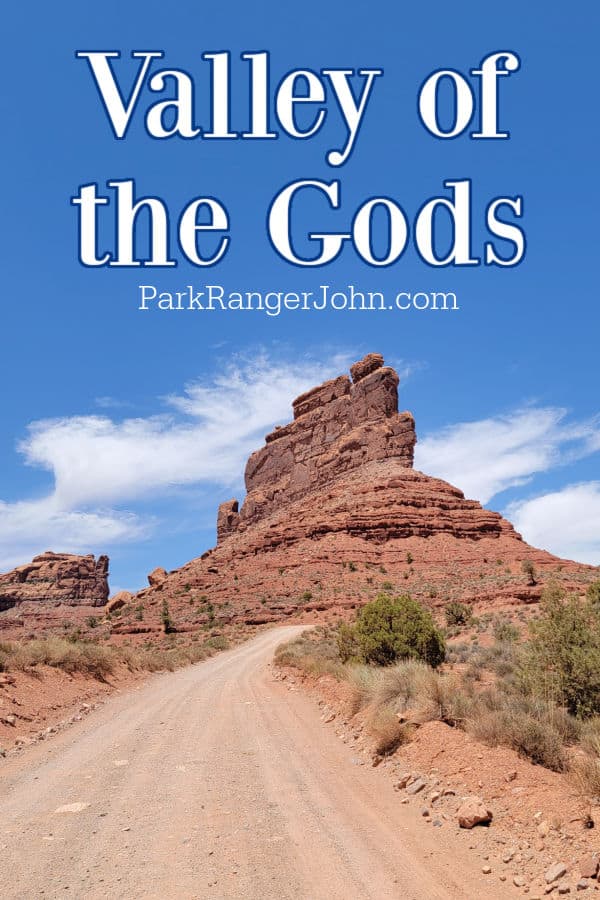
Valley of the Gods Utah
The Valley of the Gods is located near Goosenecks State Park, Moki Dugway, Monument Valley, and Bears Ears National Monument in the Southwestern United States.
It is also located in the heart of an area known as the Grand Circle, a geographical location in the southwest that includes Utah, Arizona, Colorado, Nevada, and New Mexico.
This area is well known for its numerous incredible National Parks, State Parks, Tribal Lands, and much more. This place is so incredible that you could spend a lifetime exploring this region!
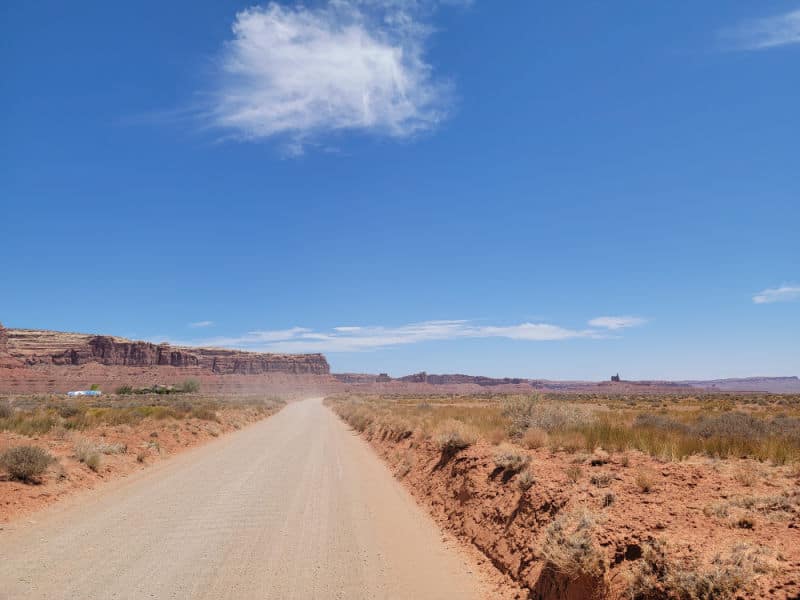
About Valley of the Gods
The landscape was slowly formed over millions of years. The power of water and ice has slowly eroded the layers of the Cedar Mesa Sandstone that dates back to the Permian Period, approximately 250 million years ago.
Erosion has left behind several jaw dropping mesas, buttes, cliffs.
Several of these rock formations have been given names like Setting Hen Butte, Castle Butte, Lady in the Bathtub, and Rooster Butte.
This land is sacred to the Navajo as the spires within contain the spirits of Navajo Warriors. This area, along with Bears Ears contain over 100,000 sites of cultural significance to the tribes and hold the history of their people written in fossils and artifacts left behind in this sacred area.
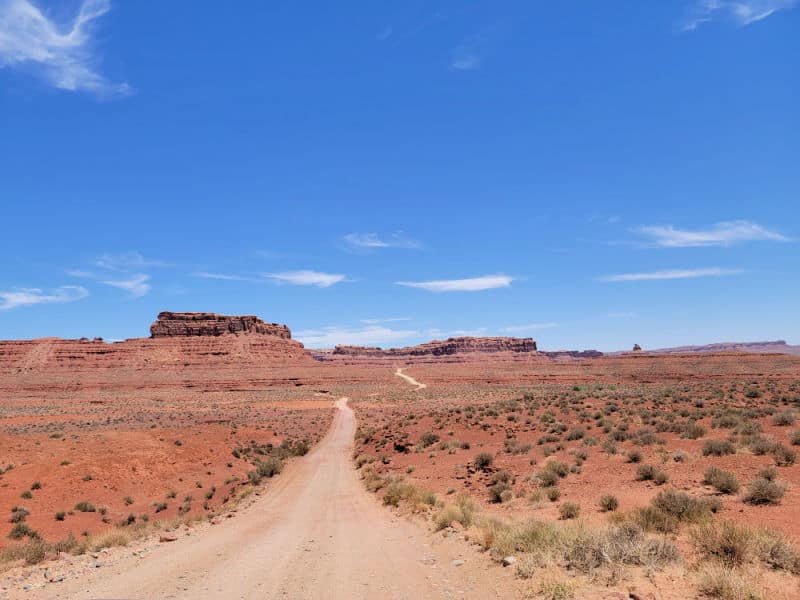
Is Valley of the Gods worth visiting?
Yes! This is a park that you can spend as little as a couple hours and complete the 17 mile scenic drive and truly get an appreciation of the area. Those who dig deeper will gain a real appreciation for this land.
I would suggest visiting Valley of the Gods and Goosenecks State Park before visiting Monument Valley.
Both parks are similar with open vistas and large buttes, mesas etc. but Monument Valley is just grand! Seriously, it is, I would say one of the top five places to see in the Southwest.
If you see Monument Valley first, Valley of the Gods will not compare even though it is incredibly beautiful.
My wife disagrees with me and thought Valley of the Gods was breathtaking. You will have to decide which one of us is right.
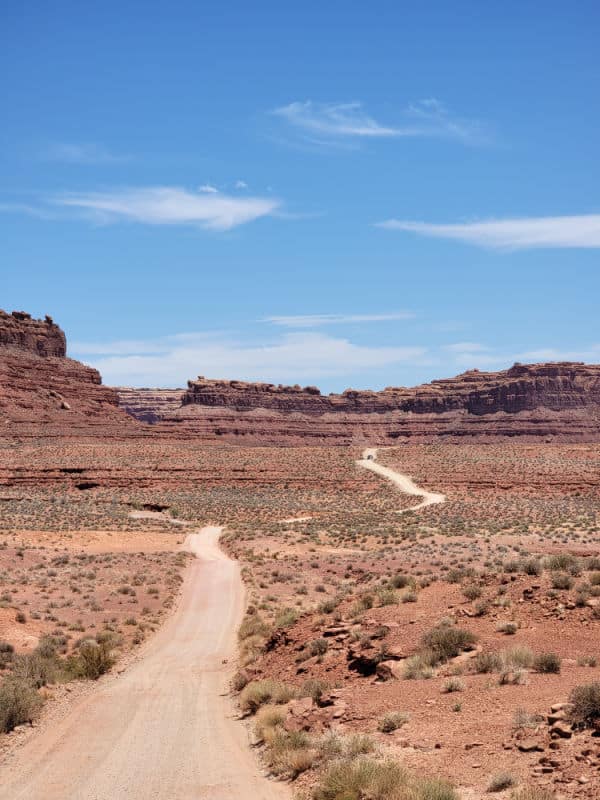
History of the Valley of the Gods
In 2008, the Federal Government recognized Valley of the Gods, designating it an Area of Critical Environmental Concern and for its scenic value.
In December 2016, President Barack Obama designated the Bears Ears Area, which included the Valley of the Gods as a BLM National Monument.
In December 2017, President Donald Trump reduced the area of Bears Ears National Monument.
The new boundaries excluded the Valley of the Gods, however the BLM continues to manage Valley of the Gods as it did before the designation as the area is considered an area of critical environmental concern.
This move recognizes the lands importance to the native tribes.
Part of the Bears Ears National Monument, Valley of the Gods is a breathtaking and sparsely visited site minutes from Bluff, Utah. Valley of the Gods is in southeast Utah and is home to several famous rock formations.
The valley has served as the backdrop for several TV shows, and is a free excursion near the more famous Monument Valley.
Geology/Geography
Valley of the Gods is located near the San Juan River which cuts across the Colorado Plateau before joining into the Green and Colorado Rivers.
The Valley of the Gods is part of the Four Corners region which includes portions of southwest Colorado, northwest New Mexico, northeast Arizona, and southeast Utah.
The Valley of the Gods has towering sandstone formations which are common across the Colorado Plateau. Layered sandstone formations were formed millions of years ago by the Western Interior Seaway.
Shifting coasts of this sandy inland sea pressured layers of sand into the variegated and colorful layers visible in the formations. Gold, red, and purple hues are visible in many of the formations.
Beneath the valley’s sandy and rocky soil are vast deposits of natural gas, petroleum, and significant uranium deposits.
Sacred History of the Valley of the Gods
Ancestral Puebloans were responsible for the nearby construction of the great houses of Chaco Canyon and the cliff dwellings of Mesa Verde built during the 9th-11th centuries. Modern groups who trace their lineage to the Puebloans along with the Navajos who migrated into the area in the 12th century both attribute great spiritual importance to the formations in and near the Valley of the Gods.
The tribal histories of the Ute, Zuni, Navajo, and Hopi all locate their creation myths in lands near the Valley of the Gods. Ute origin stories see the Valley of the Gods and surrounding areas as their eternal homeland and also as the place where competing tribes came into being.
Navajo people see the massive sandstone landmarks in Valley of the Gods and Bears Ears National Monument as embodiments of ancient heroes whose spirit can be called upon for strength and protection.
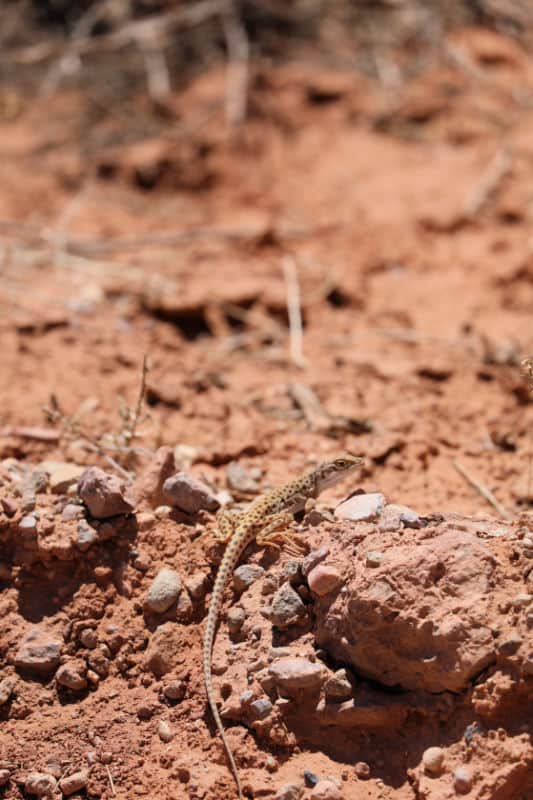
United States Possession and Contention
Following the Treaty of Guadalupe Hidalgo and the Mexican Cession at the conclusion of the Mexican-American War (1846-1848), the United States took control of the Four Corners region, California and Nevada.
This massive land expansion required huge investments of capital and adventure. The US dispatched numerous groups to chart and explore the desert Southwest.
Purchasing vast tracts of land from Mexico included lands occupied by Native Americans. Spain, and later Mexico, both claimed the homelands of numerous Native American groups. The land gains resulting from the Mexican-American War folded these tribes into the expanding United States.
Competing claims to ownership and control of these lands preceded the Mexican Cession and continue to this day.
Changing Status of the Park
Many attempts have been made since the early 1900s to designate the Valley of the Gods as a national monument or park. These efforts failed until the 2000s.
A federal raid carried out in Blanding, Utah revealed thousands of looted artifacts from the area that currently comprises Bears Ears National Monument. This raid highlighted for many the importance of preserving and protecting the physical and spiritual history of the Valley of the Gods and Bears Ears National Monument.
The status of Valley of the Gods as an official National Monument has become a contentious issue. In 2016, former President Barack Obama created Bears Ears National Monument which at the time included the Valley of the Gods.
The following year former President Donald Trump reduced the size of the monument. The redrawn boundaries excluded Valley of the Gods. Then, in 2021 President Joe Biden restored the original boundaries of the park as determined under the Obama administration.
This back and forth over the size and scope of the newly created monument has led to confusion and agitation. Many different groups have claims to the area. Native American tribes see it as a sacred site imbued with spiritual and historical significance.
Important ceremonial and healing herbs are found within the Valley of the Gods.
Outdoor enthusiasts want guaranteed protection of the pristine environment which currently contains no official trails or paths. While borders were reduced, many companies clamored for access to uranium, petroleum, and natural gas deposits.
Legal challenges to the reduction of the size of Bears Ears National Monument were filed, while counterclaims are challenging the expansion of the park and the voiding of resource extraction contracts. Currently, Valley of the Gods is part of Bears Ears National Monument.
Luckily for visitors wishing to visit the park, the challenges surrounding the status of the park during the late 2010s and early 2020s have not altered its accessibility or its natural beauty. The park is opened to visitors via a 17-mile gravel loop.
Visitors can camp in designated areas and walk anywhere in the park on trails of their own making.
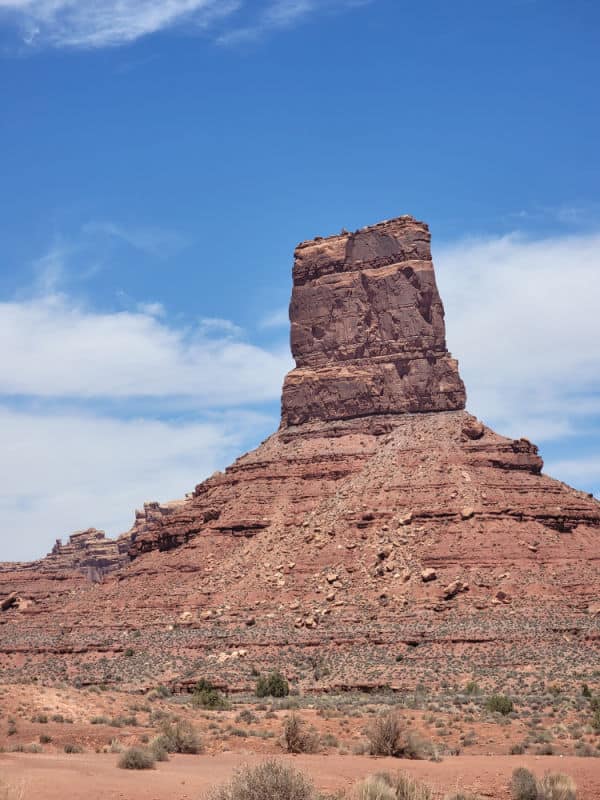
Things to know before your visit to Valley of the Gods
Entrance fee
$0.00 - there is no entrance fee for visiting the park.
Learn more about National Park Passes for parks that have an entrance fee.
$80.00 - For the America the Beautiful/National Park Pass. The pass covers entrance fees to all US National Park Sites and over 2,000 Federal Recreation Fee Sites for an entire year and covers everyone in the car for per-vehicle sites and up to 4 adults for per-person sites.

Buy your pass at this link, and REI will donate 10% of pass proceeds to the National Forest Foundation, National Park Foundation, and the U.S. Endowment for Forestry & Communities.
National Park Free Entrance Days -Mark your calendars with the five free entrance days the National Park Service offers annually.
Time Zone
Mountain Standard Time (MST)
Pets
Pets are never allowed in archeological sites
Cell Service
Spotty at best, we had very little cellular coverage with T-Mobile
Park Hours
The park is open year-round however the road can be challenging based upon weather conditions.
Wi-Fi
No WIFI available in the park
Insect Repellent
Insect repellent is always a great idea when outdoors, especially if you are around any body of water.
We use Permethrin Spray on our clothes before our park trips.
Water Bottle
Make sure to bring your own water bottle and plenty of water with you. Plastic water bottles are not sold in the park.
Parking
There are no designated parking lots in the park but there is visible pullouts along the 17 mile stretch of road. There should be no problems with finding a place to pull over
Food/Restaurants
There are no restaurants in or near the park.
Gas
There is no gas station in or near the park (Plan ahead)
Drones
Unknown at this time. Generally, drones are allowed on BLM lands. I would call the Bureau of Land Management office at (435) 587-1510
Electric Vehicle Charging
he closest vehicle charging stations are located at 455 W Main St, Bluff, UT 84512 and 12 N Grayson Pkwy, Blanding, UT 84511
Details about Valley of the Gods
Size - 360,000 Acres
Valley of the Gods HQ Address
BLM Monticello Field Office
365 North Main
Monticello, UT 84535
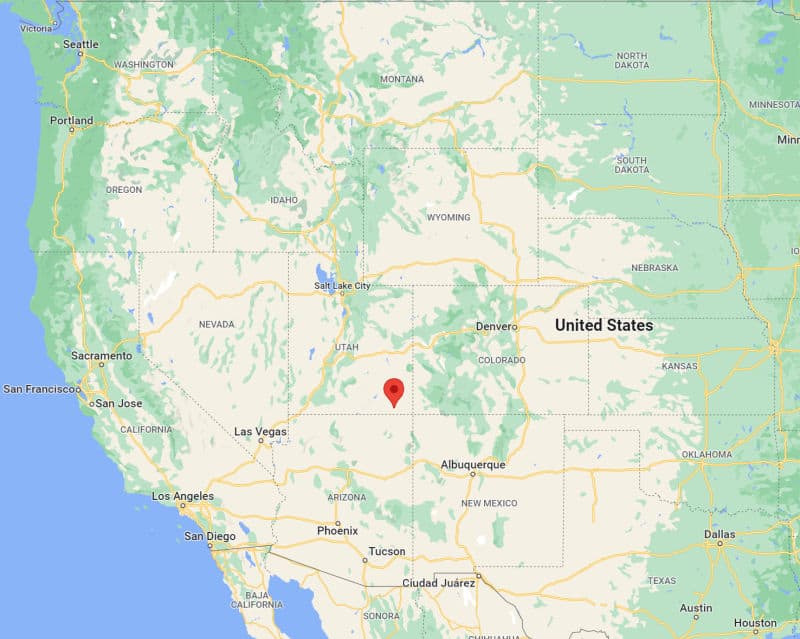
Where is Valley of the Gods?
Valley of the Gods is located in the Southeastern corner of Utah in the four corner region of the United States.
Monument Valley to Valley of the Gods
You can drive a short 40 miles and be at Monument Valley. It will take approximately an hour to get there.
Estimated distance from major cities nearby
- Mexican Hat, Utah - 10 miles
- Bluff, Utah - 27 miles
- Cortez, Co - 103 Miles
- Farmington, NM - 125 Miles
- Moab, UT - 128 Miles
- Page, AZ - 153 Miles
- Flagstaff, AZ - 203 Miles
- Albuquerque, NM - 309 Miles
Estimated Distance from nearby Parks
Goosenecks State Park - 8 Miles
Moki Dugway - 1 Mile
Natural Bridges National Monument - 32 Miles
Monument Valley - 40 Miles
Upper Antelope Canyon - 146 Miles
Canyonlands National Park (Needles District) - 109 Miles
Where is the Valley of the Gods Visitor Center?
There is no visitor center at the Valley of the Gods.
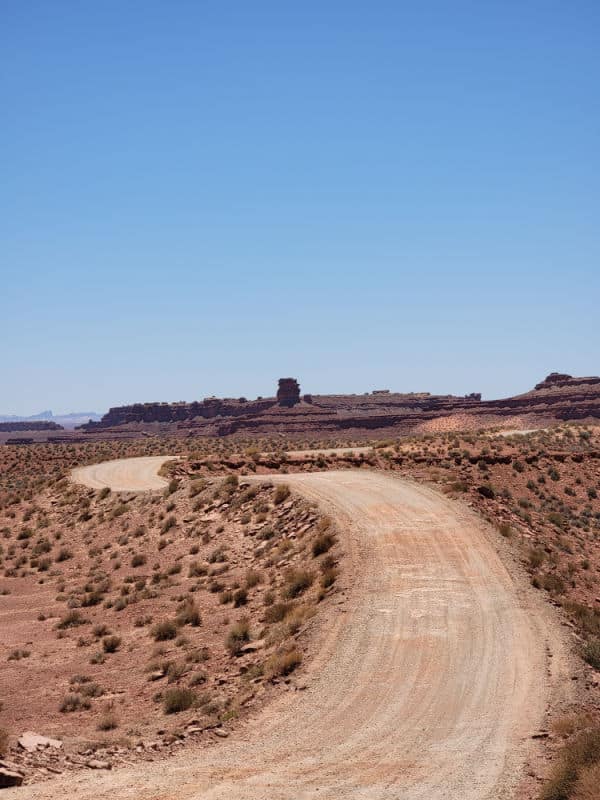
Getting to Valley of the Gods, Utah
Closest Airports
Distance calculated from Mexican Hat, Utah
Cortez Municipal Airport (CEX) - 99 miles
Four Corners Regional Airport (FMN) - 131 miles
Page Municipal Airport (PGA) - 141 miles
Canyonlands Field (CNY) - 143 miles
Durango-La Plata County Airport (DRO) - 179 miles
Montrose Regional Airport (MTJ) - 238 miles
Albuquerque International Sunport (ABQ) - 337 miles
Driving Directions
The Valley of the Gods can be accessed from either Utah Highway 261 (Approximately 10 miles Northeast of Mexican Hat, UT.) or by taking US Highway 163(approximately 15 miles West of Bluff, UT.).
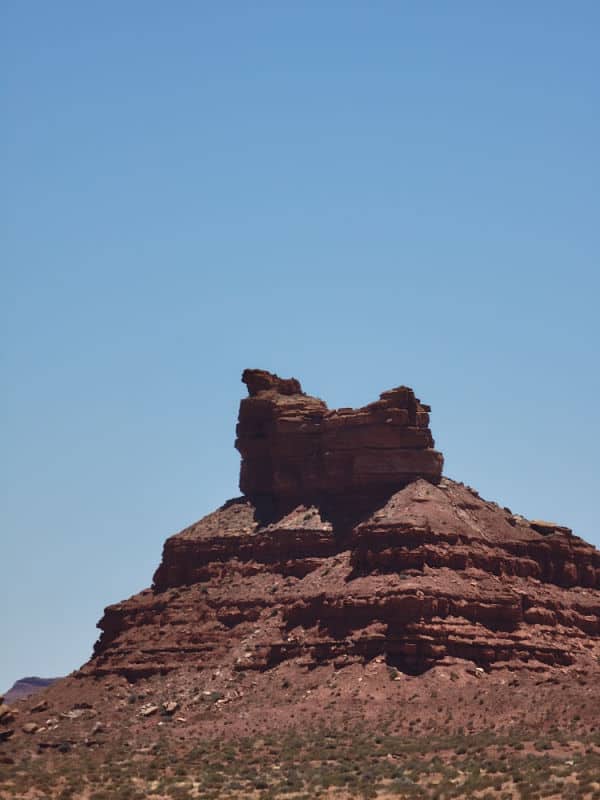
Best time to visit Valley of the Gods
The best time to visit the Valley of the Gods is Spring (March-mid June) and fall (September-October) This is when the weather is the best. The best time for photography is sunrise and sunset, especially the golden hour.
This is when you will get the deep blue-colored skies and the deep red saturation of the rocks making people envious of your photos!
The best times to visit are spring (March to early June) and fall (September to October). Summer months can become oppressively hot, and are right in the middle of monsoon season.
For the best view of saturated red rock and deep-hued blue skies, visit the park at sunset or sunrise. When wet, the roads through Valley of the Gods might become impassible, so take caution and check the weather forecast before venturing out.
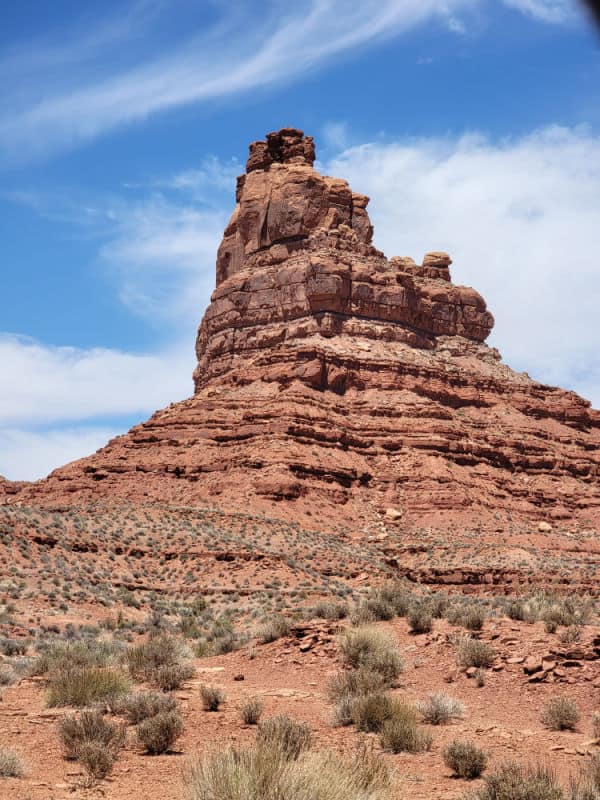
Valley of the Gods Weather and Seasons
Spring and Fall are great times to visit the park. The temperatures are pleasant for you to get out and explore this area.
The temperatures in the summer can be downright unbearable, even dangerous for the ill-prepared.
You will most likely have the place to yourself in the winter.
Having said that, you need to be prepared to take care of yourself including being able to get out if you get stuck in poor road conditions or a vehicle breakdown.

Best Things to do in Valley of the Gods
17 Mile Scenic Drive
The 17-mile scenic drive takes you through the heart of the park and past many of the park's main attractions. It is an easy drive that will take an hour or two to complete.
I completely loved this drive and for several reasons. First off, you can easily find solitude here and not feel like you are being herded like a bunch of cattle at some of the major attractions in the Southwest.
I actually stopped my vehicle in the middle of the road and got out and took photos. Why? Because I Could!
Not only that but there wasn't someone standing over my shoulder waiting for me to move so that they can take the exact same photo!
There was literally nobody within eyesight. It was as if we had this incredible place all to ourselves and we soaked in every minute of it because we knew where we were heading and that was not going to happen.
The colors, rock formations, and deep blue skies are a photographer's dream come true! I could have easily spent all day here just taking pictures.
The park has incredible rock formations and you can easily see Monument Valley in the background in some places in the park, how epic!
The scenic drive is County Road 242, a graded gravel and clay surface road (dirt road) that crosses several dry washes and has a few sharp turns but nothing that most vehicles could not handle in good driving conditions.
Poor driving conditions can be a whole new scenario, especially after inclement weather like heavy rain. The road can become completely impassible and you could find yourself with a really long hike home or an extravagant tow bill, neither of which seem pleasant.
Make sure to take a copy of the map above as it can be very helpful so you know what rock formations you are looking at.
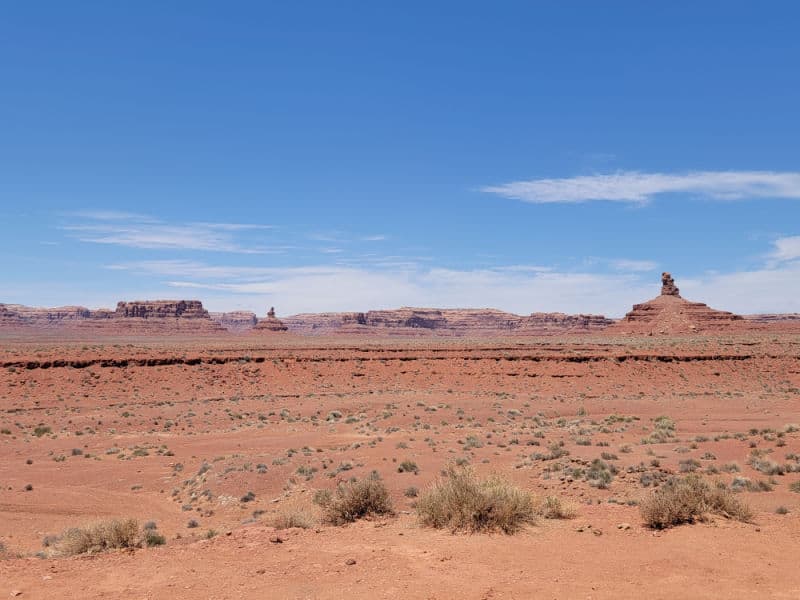
Hiking in Valley of the Gods
Always carry the 10 essentials for outdoor survival when exploring.
There are no designated trails in the Valley of the Gods.
Muley Point Overlook
The Muley Point overlook (part of the Glen Canyon National Recreation Area) is located at the top of the Moki Dugway on County Road B241. This point is not in Valley of the Gods but provides and epic look over the area.
Here you will get outstanding views of Monument Valley, John's Canyon, and Navajo Mountain as you stand next to a 1,200' sheer cliff.
This is not advised when the road is wet as the road becomes impassable.
How to beat the crowds in Valley of the Gods?
In reality, all you need to do is show up. This hidden gem has epic views but does not have the mass crowds like Monument Valley. We saw only a few cars the entire time we were exploring the 17 mile auto tour.
Where to stay when visiting Valley of the Gods?
There are no lodging options in the park.
There is a Valley of the Gods B&B with 4 rooms available right at the park's west entrance of the scenic drive. I personally don't know anything about this property but you can check out their website and give them a call if you want to stay the night at (970)749-1164
Click on the map below to see current rates for hotels and vacation rentals near Valley of the Gods.
Most of the lodging is in Mexican Hat, Blanding, or Bluff, Utah.
Goulding's Lodge - 3-star lodge, At Goulding's Lodge, you can look forward to a terrace, a gym, and a restaurant. Guests can connect to free in-room Wi-Fi.
San Juan Inn - located in Mexican Hat. A grocery/convenience store, a terrace, and a coffee shop/café are just a few of the amenities provided at San Juan Inn. The onsite restaurant, The Juan, features American cuisine. Free in-room Wi-Fi is available to all guests, along with laundry facilities and a gym.
Desert Rose Resort & Cabins - located in Bluff. Bluff Fort. Take advantage of a terrace, a garden, and laundry facilities at Desert Rose Resort & Cabins. In addition to a 24-hour gym and a business center, guests can connect to free in-room Wi-Fi.
Bluff Dwellings Resort - located in Bluff. 3.5-star hotel at Bluff Dwellings Resort and take advantage of a grocery/convenience store, a terrace, and a firepit. Treat yourself to a manicure/pedicure, a body treatment, or a massage at the onsite spa. Stay connected with free in-room Wi-Fi, and guests can find other amenities such as a coffee shop/café and a gym.
Camping
There is primitive camping available.
There are several car camps along this route. However, no campfires are allowed.
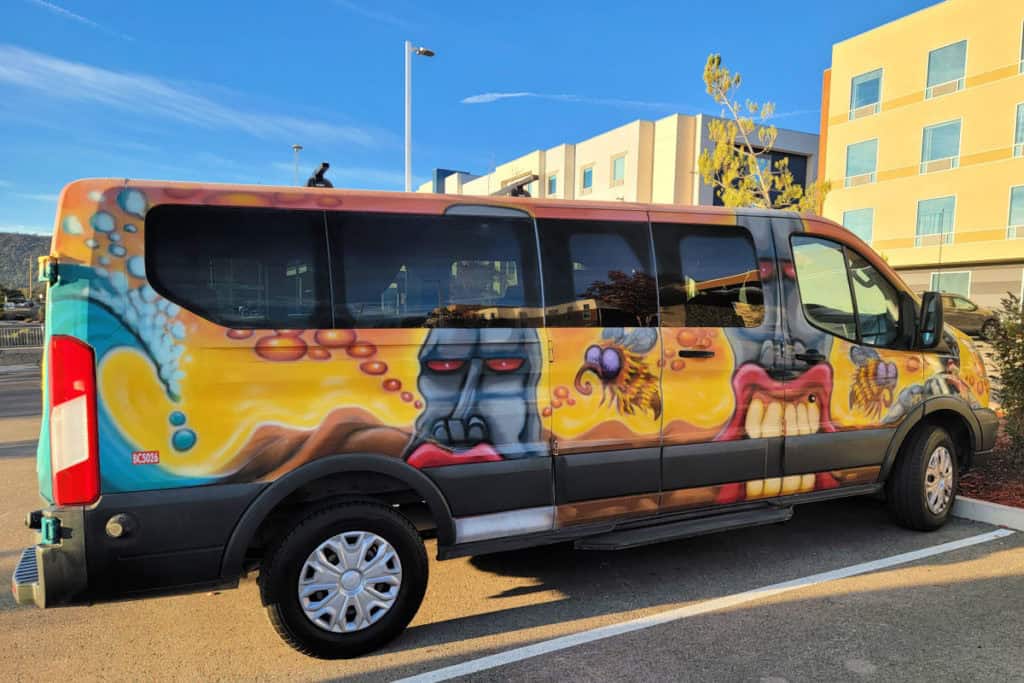
For a fun adventure check out Escape Campervans. These campervans have built in beds, kitchen area with refrigerators, and more. You can have them fully set up with kitchen supplies, bedding, and other fun extras. They are painted with epic designs you can't miss!
Escape Campervans has offices in Vancouver, Seattle, Portland, San Francisco, Las Vegas, Los Angeles, Phoenix, Salt Lake City, Denver, New York, and Orlando
Movies filmed in Valley of the Gods
- Forrest Gump
- Thelma & Louise
- To Wong Foo! Thanks for everything! Julie Newmar
- Chill Factor
- Doctor Who
- Navajo Dream 3
- Walking in the Valley of the Gods
National Parks near the Valley of the Gods
Black Canyon of the Gunnison National Park
Great Sand Dunes National Park
Check out all of the Utah National Parks along with neighboring National Parks in Wyoming, National Parks in New Mexico, National Parks in Nevada, Idaho National Parks, Colorado National Parks, and Arizona National Parks
Make sure to follow Park Ranger John on Facebook, Instagram, Pinterest, and TikTok


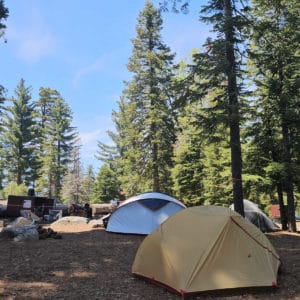
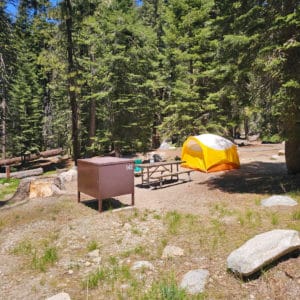
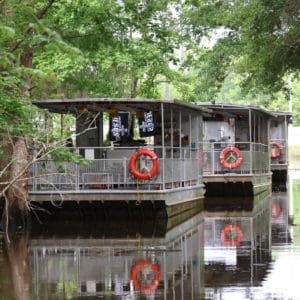
Leave a Reply